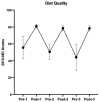Healthy Dietary Pattern Cycling Affects Gut Microbiota and Cardiovascular Disease Risk Factors: Results from a Randomized Controlled Feeding Trial with Young, Healthy Adults
- PMID: 39519452
- PMCID: PMC11547453
- DOI: 10.3390/nu16213619
Healthy Dietary Pattern Cycling Affects Gut Microbiota and Cardiovascular Disease Risk Factors: Results from a Randomized Controlled Feeding Trial with Young, Healthy Adults
Abstract
Background: Previous research demonstrates that adopting, abandoning, and re-adopting (i.e., cycling) a healthy dietary pattern (HDP) improved, reverted, and re-improved cardiovascular disease (CVD) risk factors. In addition, changes in CVD risk factors are associated with dietary modifications of gut microbiota.
Objective: We sought to assess the effects of cycling an HDP on gut microbiota and CVD risk factors.
Methods: Retrospectively, we used data from a randomized controlled, crossover trial with three 3-week controlled dietary interventions, each separated by a 5-week period of participant-chosen, uncontrolled food intake. Seventeen participants (10 males, 7 females, age 26 ± 4 years old, BMI 23 ± 3 kg/m2) all consumed intervention diets that followed healthy U.S.-style dietary patterns. Gut microbiota composition and cardiovascular risk factors were measured before and after each HDP.
Results: Repeatedly adopting and abandoning an HDP led to a cycling pattern of changes in the gut microbial community and taxonomic composition. During the HDP cycles, relative abundances of several bacterial taxa (e.g., Collinsella, Mediterraneibacter, Romboutsia, and Dorea) decreased and returned to baseline repeatedly. Similar HDP cycling occurred for multiple CVD risk factors (i.e., serum total cholesterol and LDL-C concentrations). Consistent negative associations were observed between changes in Mediterraneibacter or Collinsella and serum total cholesterol/HDL-C ratio.
Conclusions: These results support previous findings that HDP cycling affected multiple CVD risk factors and expand the HDP cycling phenomenon to include several bacterial taxa. Young adults are encouraged to adopt and sustain a healthy dietary pattern to improve cardiovascular health, potentially through modifying gut microbiota composition.
Keywords: dietary adherence; gut microbiome; healthy eating pattern.
Conflict of interest statement
During the time this research was conducted, W.W.C. received funding for research grants, travel or honoraria for scientific presentations, or consulting services from the following organizations: U.S. National Institutes of Health, U.S. Department of Agriculture (Hatch Funding), Pork Checkoff, National Pork Board, Beef Checkoff, North Dakota Beef Commission, National Cattlemen’s Beef Association, Foundation for Meat and Poultry Research and Education, American Egg Board, Whey Protein Research Consortium, National Dairy Council, Barilla Group, Mushroom Council, and the National Chicken Council. During the time this research was conducted, S.R.L. received funding for research grants, travel or honoraria for scientific presentations, or consulting services from the following organizations: U.S. National Institutes of Health, U.S. Department of Agriculture, U.S. National Science Foundation, C.P. Kelco, Inc., OLIPOP, Inc., Council for Responsible Nutrition, and the Grain Foods Foundation. Y.W., T.-W.L.C. and M.T. declare no conflict of interest. The funders and these other organizations had no role in the design of the study; in the collection, analyses, or interpretation of data; in the writing of the manuscript; or in the decision to publish the results.
Figures






Similar articles
-
Effects of Adding Lean Red Meat to a U.S.-Style Healthy Vegetarian Dietary Pattern on Gut Microbiota and Cardiovascular Risk Factors in Young Adults: a Crossover Randomized Controlled Trial.J Nutr. 2023 May;153(5):1439-1452. doi: 10.1016/j.tjnut.2023.03.013. Epub 2023 Mar 14. J Nutr. 2023. PMID: 36921804 Clinical Trial.
-
Effects of defatted rice bran-fortified bread on gut microbiome, cardiovascular risk, gut discomfort, wellbeing and gut physiology in healthy adults with low dietary fibre intake.Clin Nutr ESPEN. 2025 Jun;67:362-376. doi: 10.1016/j.clnesp.2025.03.045. Epub 2025 Mar 22. Clin Nutr ESPEN. 2025. PMID: 40127766 Clinical Trial.
-
Short-Term Effects of Healthy Eating Pattern Cycling on Cardiovascular Disease Risk Factors: Pooled Results from Two Randomized Controlled Trials.Nutrients. 2018 Nov 10;10(11):1725. doi: 10.3390/nu10111725. Nutrients. 2018. PMID: 30423846 Free PMC article. Clinical Trial.
-
Mediterranean-style diet for the primary and secondary prevention of cardiovascular disease.Cochrane Database Syst Rev. 2019 Mar 13;3(3):CD009825. doi: 10.1002/14651858.CD009825.pub3. Cochrane Database Syst Rev. 2019. PMID: 30864165 Free PMC article.
-
Dietary glycation compounds - implications for human health.Crit Rev Toxicol. 2024 Sep;54(8):485-617. doi: 10.1080/10408444.2024.2362985. Epub 2024 Aug 16. Crit Rev Toxicol. 2024. PMID: 39150724
Cited by
-
The role of gut-islet axis in pancreatic islet function and glucose homeostasis.Diabetes Obes Metab. 2025 Apr;27(4):1676-1692. doi: 10.1111/dom.16225. Epub 2025 Feb 6. Diabetes Obes Metab. 2025. PMID: 39916498 Free PMC article. Review.
References
-
- U.S. Department of Agriculture. U.S. Department of Health and Human Services . Dietary Guidelines for Americans, 2020–2025. 9th ed. U.S. Department of Health and Human Services; Washington, DC, USA: 2020. [(accessed on 1 May 2022)]. U.S. Department of Agriculture. Available online: http://www.dietaryguidelines.gov/
-
- NHANES—What We Eat in America. [(accessed on 13 May 2022)]; Available online: https://www.cdc.gov/nchs/nhanes/wweia.htm.
Publication types
MeSH terms
Grants and funding
LinkOut - more resources
Full Text Sources

